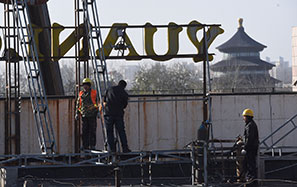Hunt for treasure yields artifacts in river
Archaeologists' finds listed among China's top discoveries in 2017
Nearly three months of digging for sunken treasure in a section of the Minjiang River in Meishan, Sichuan province, has yielded 12,000 relics that are 400 years old.
Archaeologists have unearthed gold, silver and iron weapons, including a blunderbuss, a type of firearm. The dig started in January in a section of the river that runs through Jiangkou township in the city's Pengshan district.
|
Workers pass sand in baskets at the archaeological excavation site in a section of the Minjiang River in Meishan, Sichuan province, on April 23 (top photo). Numerous silver ingots, gold earrings and weapons were unearthed at the site. Liu Kun / Xinhua |
It's the first time that archaeologists have unearthed a blunderbuss since the first effort began in January 2017. That dig lasted 98 days before the arrival of the flood season and yielded more than 30,000 relics. More than 1,000 of those items related directly to the Daxi Kingdom, which was founded by Zhang Xianzhong, a rebel leader during the Ming Dynasty (1368-1644). They offer evidence that this spot in the river was where Zhang's fleet of about 1,000 vessels was attacked and destroyed by a Ming general in 1646, two years after the dynasty's demise, says Gao Dalun, president of the Sichuan Cultural Relics and Archaeology Research Institute.
The excavation in Jiangkou was listed as one of China's top archaeological finds in 2017.
Both archaeological digs in Jiangkou have received financial support from the National Administration of Cultural Heritage in Beijing.
The blunderbuss found in the more recent dig is of great significance because it suggests a fierce battle, says Li Fei, a leading archaeologist at the research institute.
Zhang, a native of today's Shaanxi province, led a farmers' revolt, capturing Chengdu, the capital, and declaring himself emperor of the Daxi Kingdom in 1644.
He was forced to flee the city two years later and was ultimately defeated and killed by troops of the Qing Dynasty (1644-1911) from Northeast China, after he and his men were ambushed in Jiangkou by Yang Zhan, a Ming general, who set the rebels' boats on fire.
Since the 1950s, bulk silver, gold and coins have been found in Jiangkou from time to time. The Meishan police said in October 2016 that they had detained 10 gangs for digging illegally for relics and had broken up trading networks involving 70 people after more than a year of investigation.
That prompted archaeologists to start the first underwater archaeological dig in Sichuan last year. In both that dig and the one this year, temporary dams were built to divert water before the research institute began its excavation.
Archaeologist also found gold rings, gold and silver earrings and hairpins. The silver earrings and silver hairpins are so numerous that they have been piled together by the institute.
According to Zhou Chunshui, an expert in the protection of underwater cultural heritage from the National Administration of Cultural Heritage, the jewelry found in Jiangkou came from common people.
Chronicles in Sichuan suggest that Zhang was ruthless and looted wealth from governments as well as ordinary people.
huangzhiling@chinadaily.com.cn



















